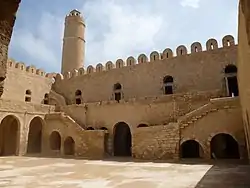Ribat of Sousse
Ribat of Sousse (Arabic: رباط سوسة) is a ribat in the city of Sousse, Tunisia. The original construction dates back to the Aghlabid era in the 8th century.
| Ribat of Sousse رباط سوسة | |
|---|---|
| Sousse, Tunisia | |
 View from the courtyard | |
| Type | Aghlabid Ribat |
| Site information | |
| Condition | Intact |
| Site history | |
| Built | 8th century[1] |
| Built by | Ibrahim the Great |
| Materials | stone, sand, carved shells, marble, granite, wood, rubble[1] |
Description
The ribat was initially constructed by the Aghlabid ruler Ibrahim the Great in the 8th century. During this time, the building had a modest structure. It was restored during the rule of Ziyadat Allah I in 821, who ordered a major expansion of the fort. During the restoration, two floors, basement and battlements were added, as well as thirty rooms for guards to live complete with bathroom and toilet. A mosque was also established on the terrace and used by the citizens of Sousse especially during the Eid al-Fitr or Eid al-Adha. It is considered among the first mosques built in the city, including the Great Mosque of Sousse. The ribat is also equipped with a water basin which collects rainwater for the use of drinking and washing. The basin was first built by Ibrahim the Great, which was expanded later by Ziyadullah. The ribat was built less than 10 years later than the Ribat of Monastir, which was first-built in 796. However, Ribat of Monastir formed into current shape later in around 10th century.[2][1] After the Byzantine city of Melite (modern Mdina on Malta) was captured by the Aghlabids in 870, marble and columns plundered from its churches was used to build the Ribat.[3]
References
| Wikimedia Commons has media related to Ribat of Sousse. |
- ربــــاط سوســـة. Governorate de Sousse. Retrieved January 30, 2018.
- معالم تونسية: رباط سوسة: شيده ابراهيم الأكبر وأعاد بناءه ابنه زيادة. Turess. Retrieved January 30, 2018.
- Brincat, Joseph M. "New Light on the Darkest Age in Malta's History" (PDF). melitensiawth.com. Archived from the original (PDF) on 4 March 2016.
